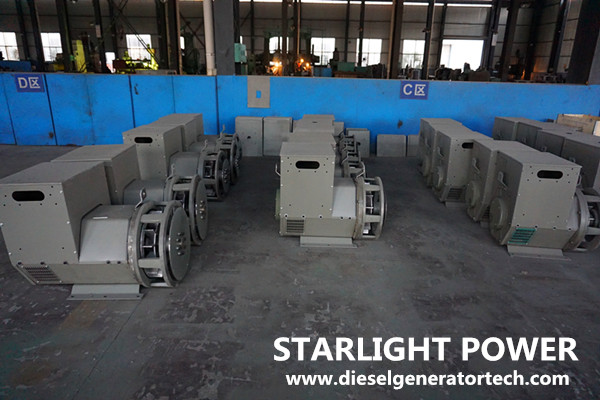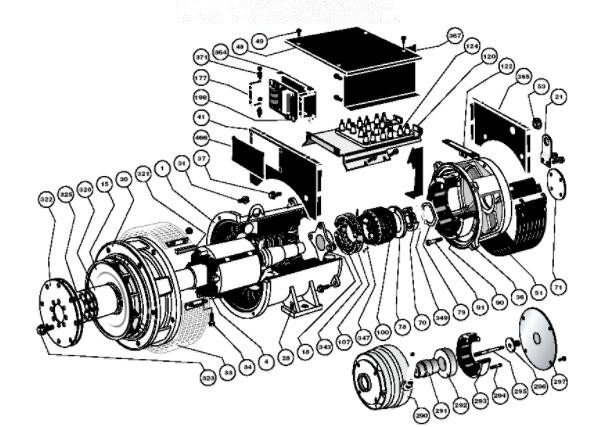Generator is widely used in our daily life. When we buy generator, should we choose single-phase generators or three-phase generator?
Application of Generator:
Single phase generator - Normally for residential use
Three phase generator - For industrial use
Single-phase generator produces one single voltage that alternates continuously. Because the power is generated in one single wave, the level varies throughout its cycle. These varying waves cause the power level to drop throughout the process, however, these drops generally go undetected to the eye and ear in normal, residential and smaller operations. Most single phase portable generator operate anywhere from 120 to 240 volts.
Three-phase generator is driven by the prime mover to drive the DC-excited generator rotor to rotate at a rotating speed. According to the principle of electromagnetic induction, the three-phase stator winding induces an alternating current potential. If the stator winding is connected to an electrical load, the motor has an AC power output.
The three-phase generator is widely used in driving mechanical equipment that does not require speed regulation and high power because it has good characteristics of maintaining constant speed when the power supply voltage fluctuates or the load torque changes. In general, three phase generator is more powerful.

Single Phase Generator VS Three Phase Generator
Single phase generators are ideal for rural area since it doesn’t require constant, high voltage power. Most of them operate anywhere from 120 to 240 volts. However, three phase generators are ideal for heavy duty industrial application that require constant power. The three phase generators are more efficient and safe power. Diesel generator set usually uses three phase generator as its synchronous generator.
The single phase is 220 volts, the phase-to-zero voltage; the three-phase is the phase-to-phase voltage of 380V between a.b.c, and the electrical appliance is a three-phase 380V motor or device. Three-phase power is mainly used as a power source for the motor, that is, the load that needs to be rotated. Because the three phase differences of the three-phase power are both 120 degrees, the rotor will not be stuck, and the three-phase electricity is to form this "angle". Otherwise, it is not necessary for people to engage in such complicated three-phase electricity.
Three-phase power, there are 4 wires, 3 of which are 220v live wire, 1 is zero wire. Combining any one of the live wire and the zero wire is the electric/Mains supply that we usually say, and 220v electricity, but for the balance of three-phase electricity, it is suggested to connect the corresponding load if possible. A diesel generator capable of generating equal amplitudes, equal frequencies, and 120° phase difference potential is called three-phase diesel generator.
Three-phase electricity can provide a more reasonable power source. As a motor energy source, no other things are needed. As long as the three-phase electricity is directly connected to the motor, the motor can operate. If it is single phase motor, you need to add a complicated thing to the motor to ensure the motor is running.
Usually, three phase generators include the following main parts:

1. Stator - The stator is the part of the motor or generator that is stationary. The stator is composed of stator core, stator winding and base. The main role of the stator is to generate a rotating magnetic field.
2. Rotor - The rotor of the alternator is generally composed of core, slip ring and fan blade. The main function of the rotor is to be cut by magnetic field line in a rotating magnetic field to generate (output) current.
3. Exciter armature - The armature is a part of the generator with a wire, which causes it to rotate in the magnetic field due to the relative movement of the wire through the magnetic field between the pole pieces, the current induced in the wire, or the magnetic induction caused by the current through the wire.
4. Exciter stator
5. Rotating diode rack
6. AVR - Automatic voltage regulator is a sealed electronic device, which controls the magnetic field of the low power exciter and adjusts the rectifier output power of the exciter armature, so as to meet the requirements of controlling the magnetic field current of the main engine and stabilizing the output voltage of the brushless generator. It is with low frequency and no input signal protection device.
7. Bearing - Bearing is an important component in modern mechanical equipment. Its main function is to support the mechanical rotating body, reduce the friction coefficient during the movement, and ensure its accuracy.
8. Armature winding – The armature winding is composed of a certain number of armature coils connected according to a certain rule. It is the circuit part of the DC motor, and is also the part that generates the electromotive force and generates electromagnetic torque for electromechanical energy conversion. The armature winding is divided into two categories: DC armature winding and AC armature winding.
Starlight Power is a professional manufacturer of design, research and development, production, manufacturing and supply, commissioning, maintenance of diesel generator set, with equipment testing station, 43 years of production and manufacturing experience, long-term supply of 20kw to 2500kw diesel generators for customers. Perfect after-sale and high-quality products have won the favor of customers.
Comments
Post a Comment